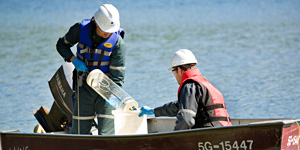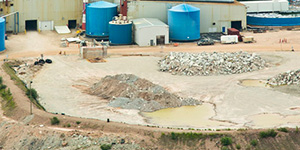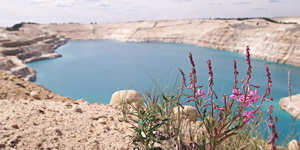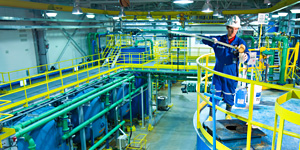Responsible Stewardship
Modern uranium mines have developed and implemented effective measures to protect the environment.
Like other metal mines, uranium operations need to safely manage waste rock, contain mill tailings, effectively treat water used in mine and mill processes, and reclaim disturbed lands when mining is complete.
Environmental assessment
Uranium mines are subject to extensive environmental assessment before construction begins. The process starts with baseline studies to document the pre-development state of the environment. Studies include testing of water bodies and air quality, studies of the plants and animals of the area, and also consider social and economic factors. Potential effects on the environment are identified through the process and measures to mitigate them are developed. Local people and other stakeholders are consulted extensively as part of the process to ensure their concerns are addressed. Once it has been demonstrated that a project is safe for people and the environment, regulatory approval may be granted.
Ongoing monitoring

Uranium mines are generally the most regulated, monitored and best understood type of mining in the jurisdictions in which they operate. In addition to normal government regulation applied to mining operations, national regulators such as the Canadian Nuclear Safety Commission in Canada and the Nuclear Regulatory Commission in the US oversee uranium mining operations and apply additional requirements.
Typical monitoring programs at uranium mines include regular testing of air, water, plants and animals both in the immediate vicinity of an operation and downstream. Operational aspects such as the quality of treated water released by an operation, air emissions and the performance of waste management facilities are also closely monitored.
The results of monitoring programs are reported to the public through licensing processes and other channels to demonstrate the environmental performance of uranium mines and address public concerns.
As a result of intensive monitoring and regulatory oversight, uranium mines have developed leading practices for the protection of health and safety of people and the environment. These practices are continually improved to reflect changes in scientific knowledge and have been applied to other types of mining to improve the environmental performance of the mining industry generally.
Waste rock management

Waste rock generated by uranium mining operations is managed to protect the surrounding environment. The main risk related to waste rock is that it can generate acidic runoff when stored on the surface that can transport heavy metals into the environment.
All waste rock is tested to identify its properties and determine the type of measures required to safely store it on surface. When required, runoff water from waste rock storage areas is collected and treated to remove contaminants. Special covers and drainage systems are also developed to control runoff and minimize all impacts to the environment.
Tailings management

Tailings are the solid waste materials that result from the processing of uranium ore as well as fine chemical residues from water treatment facilities. Uranium mine tailings typically contain heavy metals such as arsenic, cadmium, cobalt, copper, molybdenum, nickel, lead, selenium and zinc. The tailings also contain radionuclides such as uranium, thorium 230, radium 226, lead 210 and polonium 210. Modern uranium mines use engineered tailings management facilities designed to securely contain tailings through the operating life of a facility and for thousands of years after decommissioning.
For example, Cameco’s uranium mills in northern Saskatchewan store tailings in mined out pits that take advantage of natural geological features. Tailings are deposited into these facilities in slurry form during operations. Groundwater is collected by a system of wells to ensure the heavy metals and radionuclides in the tailings are contained. Water collected from these wells is treated to remove contaminants which are placed back into the tailings facility as solids.
Over the long-term, tailings stored in the facility will consolidate through physical and chemical processes to form a dense mass. Once fully consolidated, natural groundwater will flow through more porous material around the tailings mass thereby minimizing the transport of tailings into the surrounding environment. In-pit tailings management facilities are considered a best practice. Modelling demonstrates these facilities will protect the environment during operations and long into the future. Uranium mill tailings may also be safely stored in above-ground tailings management facilities. Above-ground facilities use earthworks to contain the tailings and runoff is managed to ensure contaminants are contained. These facilities can be safely be decommissioned in place and remain protective of environment for very long periods. Water treatment
All water used in mining and milling processes is treated to remove contaminants before it is released to the environment. Cameco’s uranium mining operations use a combination of conventional water treatment systems and reverse osmosis to remove heavy metals and radionuclides. The contaminants captured by these systems are typically placed in a tailings facility. Treated water, released to the environment, is tested on an ongoing basis to ensure stringent regulatory limits are met and the environment is protected.
Uranium mill tailings may also be safely stored in above-ground tailings management facilities. Above-ground facilities use earthworks to contain the tailings and runoff is managed to ensure contaminants are contained. These facilities can be safely be decommissioned in place and remain protective of environment for very long periods.
Water treatment

All water used in mining and milling processes is treated to remove contaminants before it is released to the environment.
Cameco’s uranium mining operations use a combination of conventional water treatment systems and reverse osmosis to remove heavy metals and radionuclides. The contaminants captured by these systems are typically placed in a tailings facility. Treated water, released to the environment, is tested on an ongoing basis to ensure stringent regulatory limits are met and the environment is protected.






